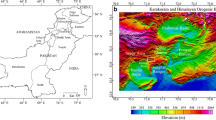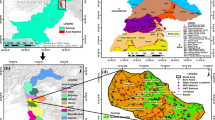Abstract
In coastal regions, the ingress of saline water into fresh water aquifers is a threatening phenomenon. The present study using electrical resistivity imaging in parts of Sindhudurg district in coastal Maharashtra, India thus assumes significance in inferring the extent of saline water incursion and the underlying structures that influence the occurrence of groundwater in basaltic rocks. The two-dimensional (2D) inversion of the field data over 18 profiles are well correlated with the available lithology. The inversion revealed the top layer consisting of alluvium/lateritic formation, followed by weathered/fractured basalts and compact basalts as bedrock. The imaging profiles at places viz., 8 (Achara), 9 (Tondavali), 7 (Munge), 20 (Vijaydurg) and 12 (Wada) situated near the coast evidenced a widespread saline water intrusion. These models further indicate that there are several locations throughout the study region along the coastal part exhibiting strong salinity effect and confirmed with low resistivity values. The 2D inverted models further suggest the occurrence of aquifers mostly in weathered/fractured zones within the traps or beneath it. Also, the resistivity models divulge that the northern part of the study area represents promising aquifer zone with reasonable thickness of weathered/fractured basement.







Similar content being viewed by others
References
Adeoti L, Alile OM, Uchegbulam O (2010) Geophysical investigation of saline water intrusion into freshwater aquifers: A case study of Oniru. Lagos State Sci Res Essays 5(3):248–259
Antony Ravindran A, Mondal NC, Ramanujam N, Srinivasamoorthy K, Anbazhagan P (2016) Appraisal of groundwater resource in Holocene soil deposits by resistivity, hydrochemical and granulomerial studies in the Gulf of Mannar Coast from Southern India. Environ Earth Sci 75:166
CGWB [Central Ground Water Board] (2014) Groundwater information Sindhudurg district Maharashtra. Technical Report for Ministry of Water Resources, Government of India, 1835/DB/2014.
Dahlin T, Zhou B (2006) Multiple-gradient array measurements for multi-channel 2D resistivity imaging. Near Surface Geophys 4:113–123
Deolankar SB (1980) The Deccan Basalt of Maharashtra, India—their potential as aquifers. Ground Water 18(5):434–437
El-Qady G, Ushijima K, El-Sayed A (2000) Delineation of a geothermal reservoir by 2D inversion of resistivity data at Hammam Faraun area, Sinai, Egypt. Proc World Geothermal Cong 1103–1108
Gupta G, Maiti S, Erram VC (2014) Analysis of electrical resistivity data in resolving the saline and fresh water aquifers in west coast Maharashtra, India. J Geol Soc India 84:555–568
Gurunadha Rao VVS, Tamma Rao G, Surinaidu L, Rajesh R, Mahesh J (2011) Geophysical and geochemical approach for seawater intrusion assessment in the Godavari Delta Basin, A.P. India Water Air Soil Pollut 217:503–514
Hamzah U, Samudin AR, Malim EP (2007) Groundwater investigation in Kuala Selangor using vertical electric sounding (VES) surveys. Environ Geol 51:1349–1359
Kumaran KPN, Shindikar M, Limaye R (2004) Mangrove associated lignite beds of Malvan, Konkan: evidence for higher sea-level during the Late Tertiary (Neogene) along the west coast of India. Curr Sci 86:335–340
Loke MH (2000) Electrical imaging surveys for environmental and engineering studies. A practical guide to 2-D and 3-D surveys
Loke MH (2001) Tutorial: 2-D and 3-D electrical imaging surveys. Course notes for USGS workshop “2-D and 3-D inversion and modelling of surface and borehole resistivity data”, Torrs, CT
Loke MH, Barker RD (1996) Rapid least-squares inversion of apparent resistivity pseudosections using a quasi-Newton method. Geophy Prospect 44:131–152
Maiti S, Erram VC, Gupta G, Tiwari RK, Kulkarni UD, Sangpal RR (2012) Assessment of groundwater quality: a fusion of geochemical and geophysical information via Bayesian Neural Networks. Environ Monit Assess 185(4):3445–3465
Mondal NC, Singh VS (2012) Delineating the fresh and brackish/saline aquifer-interface in Neill Island of Andaman-Nicobar from India: a prelude geoelectrical investigation. JASA 1:86–92
Mondal NC, Singh VP, Singh VS, Saxena VK (2010) Determining the interaction between groundwater and saline water through groundwater major ions chemistry. J Hydrol 388:100–111
Mondal NC, Singh VP, Singh S, Singh VS (2011) Hydrochemical characteristic of coastal aquifer from Tuticorin, Tamil Nadu. India Environ Monit Assess 175(1–4):531–550
Mondal NC, Singh VP, Ahmed S (2013) Delineating shallow saline groundwater zones from southern India using geophysical indicators. Environ Monit Assess 185:4869–4886
Pazdirek O, Blaha V (1996) Examples of resistivity imaging using ME 100 resistivity field acquisition system. In: EAGE 58th conference and technical exhibition extended abstracts, Amsterdam
Pujari PR, Soni AK (2009) Sea water intrusion studies near Kovaya Limestone mine, Saurashtra Coast. India Environ Monit Assess 154(1–4):93–109
Saxena VK, Mondal NC, Singh VS (2004) Identification of seawater ingress using strontium and boron in Krishna delta, India. Curr Sci 86:568–590
Singh VS, Sarwade DV, Mondal NC (2009) Evaluation of groundwater resources in a tiny Andrott Island, Union Territory of Lakshadweep. India Environ Monit Assess 158:145
Song SH, Lee JY, Park N (2007) Use of vertical electrical soundings to delineate seawater intrusion in a coastal area of Byunsan, Korea. Environ Geol 52:1207–1219
Zarroca M, Linares R, Patricio CVL, Roqué C, Lorenzo R (2015) Application of electrical resistivity imaging (ERI) to a tailings dam project for artisanal and small-scale gold mining in Zaruma-Portovelo, Ecuador. J Appl Geophys 113:103–113
Acknowledgements
The authors are grateful to Dr. D.S. Ramesh, Director, IIG, for all the support and for his kind permission to publish the work. Authors are also thankful to Shri B.I. Panchal for drafting the figures in its final form.
Author information
Authors and Affiliations
Corresponding author
Additional information
Publisher's Note
Springer Nature remains neutral with regard to jurisdictional claims in published maps and institutional affiliations.
Rights and permissions
About this article
Cite this article
Naidu, S., Gupta, G., Tahama, K. et al. Two-dimensional modelling of electrical resistivity imaging data for assessment of saline water ingress in coastal aquifers of Sindhudurg district, Maharashtra, India. Model. Earth Syst. Environ. 6, 731–742 (2020). https://doi.org/10.1007/s40808-020-00725-w
Received:
Accepted:
Published:
Issue Date:
DOI: https://doi.org/10.1007/s40808-020-00725-w




